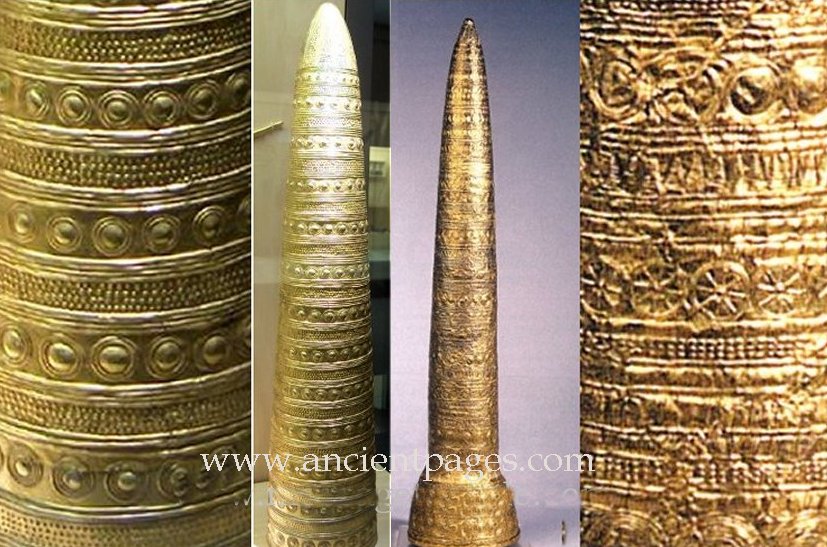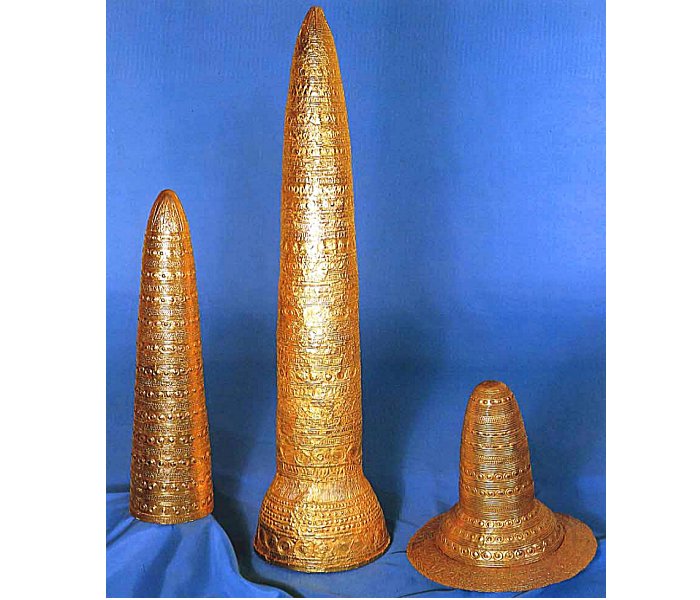Mystery Of 3,000-Year-Old Conical Hats – Was It A Highly Advanced Device?
A. Sutherland - AncientPages.com - They are considered to be "hats of ancient wizards" but their original purpose has baffled scientists for many decades.
Did wizards wear conical hats? Similar hats were worn by many gods. Quetzalcoatl wore his conical cap as Ehecatl, the snake-bird deity, and god of wind feared by the Aztecs, the Sumerian gods were often depicted in similar cone-shaped hats.
Are the circular symbols on the golden hats a proof of a highly advanced astronomical knowledge of the Bronze Age or perhaps the hats were used as cult objects in ceremonies and rituals?
If so, who was the subject of this worship?
Could the Bronze Age people possess such sophisticated astronomical skills as those presented on conical hats? Where did their advanced knowledge come from?
At first, there was only "a piece of sheet metal 8 cm below the surface of the earth. Since this disturbed the work, it was chopped up and thrown away carelessly. It was only when the sheet metal pieces were washed away by the rain that they were recognized as gold and collected by a worker's wife. Georg Raschke, then head of the prehistoric and early history collection of the Germanisches Nationalmuseum, was able to correctly classify the fragments based on the circular ornaments on them. He managed to buy the gold sheets (280 g) and when the site was examined, he found further fragments (30 g) and fragments of two bronze tires. Subsequently, it turned out that these could have been part of a hat brim reinforcement." 1
Four of the elaborately decorated cones have been uncovered at sites in Switzerland, Germany, and France over the past 170 years.
The first of them is 'Golden Hat of Schifferstadt', discovered in 1835 at Schifferstadt near Speyer, c. 1400–1300 BC; the second is the so-called 'Avanton Gold Cone' (incomplete), found at Avanton near Poitiers in 1844, and dated to c. 1000–900 BC.
The third one of these artifacts known as 'Golden Cone of Ezelsdorf-Buch', also dates back to c. 1000–900 BC and was discovered near Ezelsdorf near Nuremberg in 1953. It is the tallest known 'hat' measuring about 90 cm. The fourth is 'Berlin Gold Hat', probably originates from Swabia or Switzerland, and is dated to c. 1000–800 BC.
The gold hats are 3,000 years old and are very similar to each other regarding their form and symbolism and decoration like disks, circles, and wheel symbols.
All four hats were hammered up whole from a single piece of gold.
One of the theories proposes that mysterious conical hats were worn by "king-priests" (Lords of Time) possessing supernatural powers because of their ability to predict the correct time to sow, plant and harvest.
The tallest of them, measuring 90 cm, is that found in Ezelsdorf near Nürnberg. Germany in 1953.
According to scientists who analyzed strange artifacts, these were used to calculate the movements of the sun and the moon in advance.
Another opinion is that the cone-shaped ceremonial hats represent the conical crown of the gods from the region of the Near East, which should serve 'the cultic 'exaggeration' of a person through a high head covering.' The mysterious conical hats have been also related to the so-called 'priest-kings' (Lords of Time) who possessed supernatural powers because of their ability to predict the correct time to sow, plant, and harvest.
However, there are other interpretations of numerous combinations of both astronomical and calendrical symbols that cover four conical hats.
Mysterious hats are composed of 10 to 20 zones filled with a different number of symbols. The number of circles of each symbol and the number of symbols from one or more zones is multiplied in a first step, the total amount means a number of days.
Then the number of days is compared to astronomical cycles like the synodic month or the tropical year.
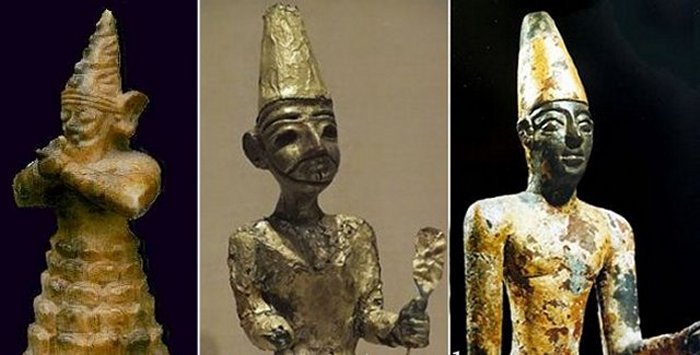
Left: Hittite figure of Baal: Canaanite God El - Megiddo, Modern Israel, c.1400 BC; Right: Phoenician deity Reshep, Byblos, 19th-18 century B
Other explanations suggest hats, quivers, calendars of a different kind, containers, crowns, and much more.
According to scientific studies, the 1,739 sun and half-moon symbols decorating the hat's surface make up a scientific, still undeciphered code which resembles 18.67-year cycle called the "Metonic Cycle" probably identified by Meton of Athens (born circa 460 B.C.; date of death unknown), a Greek mathematician, astronomer, geometer, and engineer.
But the problem is that the Meton's "discovery" took place 500 years after the mysterious conical hats were made.
Similar five golden cones were also unearthed in Ireland during the 17th and 18th centuries and even in many other places of prehistoric Europe, according to Prof Sabine Gerloff, a German archaeologist from Erlangen University, Germany and other researchers.
Written by – A. Sutherland AncientPages.com Staff Writer
Copyright © AncientPages.com All rights reserved. This material may not be published, broadcast, rewritten or redistributed in whole or part without the express written permission of AncientPages.com
Expand for referencesReferences:
D. Price, Europe Before Rome: A Site-by-Site Tour of the Stone, Bronze, and Iron Ages
More From Ancient Pages
-
 Giants Did Exist And Were A Part Of Earth’s Ancient History
Ancient Mysteries | Apr 29, 2014
Giants Did Exist And Were A Part Of Earth’s Ancient History
Ancient Mysteries | Apr 29, 2014 -
 On This Day In History: Du Fu – ‘The Sage of Poetry’ Was Born – On Feb 12, 712
News | Feb 12, 2017
On This Day In History: Du Fu – ‘The Sage of Poetry’ Was Born – On Feb 12, 712
News | Feb 12, 2017 -
 3.6 Million-Year-Old Rare Skeleton Of Human Ancestor Revealed By Researchers In South Africa
Archaeology | Dec 7, 2017
3.6 Million-Year-Old Rare Skeleton Of Human Ancestor Revealed By Researchers In South Africa
Archaeology | Dec 7, 2017 -
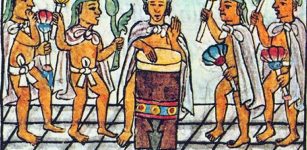 Daily Life Of Télpochcalli Students Of The Aztec Empire Was A Challenge
Ancient History Facts | Apr 20, 2020
Daily Life Of Télpochcalli Students Of The Aztec Empire Was A Challenge
Ancient History Facts | Apr 20, 2020 -
 Mystery Of The Delphi Oracle Prophecies: Was Pythia On Drugs While Guiding Ancient Greek Civilization For Thousands Of Years?
Civilizations | Nov 3, 2016
Mystery Of The Delphi Oracle Prophecies: Was Pythia On Drugs While Guiding Ancient Greek Civilization For Thousands Of Years?
Civilizations | Nov 3, 2016 -
 Unsolved Old Cherokee Mystery In The Great Smoky Mountains
Featured Stories | Feb 27, 2024
Unsolved Old Cherokee Mystery In The Great Smoky Mountains
Featured Stories | Feb 27, 2024 -
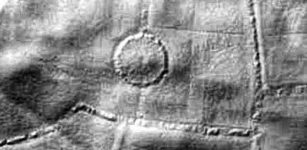 LIDAR Technology Reveals Lost Bronze Age Forts In Devon
Archaeology | May 4, 2020
LIDAR Technology Reveals Lost Bronze Age Forts In Devon
Archaeology | May 4, 2020 -
 Has An Unknown Ancient ‘Israel Silk Road’ Been Discovered?
Archaeology | Jan 20, 2023
Has An Unknown Ancient ‘Israel Silk Road’ Been Discovered?
Archaeology | Jan 20, 2023 -
 Birka Artifacts Shed Light On Vikings’ Daily Life
Artifacts | Jun 24, 2019
Birka Artifacts Shed Light On Vikings’ Daily Life
Artifacts | Jun 24, 2019 -
 ‘Exceptional’ Ancient Roman Bath Complex Discovered In Mérida, Spain
Archaeology | Aug 21, 2023
‘Exceptional’ Ancient Roman Bath Complex Discovered In Mérida, Spain
Archaeology | Aug 21, 2023 -
 First Evidence Of Canoe Burial With Remains Of A Woman Discovered In Argentinian Patagonia
Archaeology | Aug 27, 2022
First Evidence Of Canoe Burial With Remains Of A Woman Discovered In Argentinian Patagonia
Archaeology | Aug 27, 2022 -
 Ennion: Ancient Master Of Glassblowing And His Legacy
Artifacts | Dec 7, 2020
Ennion: Ancient Master Of Glassblowing And His Legacy
Artifacts | Dec 7, 2020 -
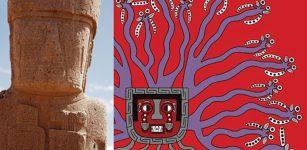 Beer And Hallucinogens Reinforced The State Of The Wari Culture
Archaeology | Jan 15, 2022
Beer And Hallucinogens Reinforced The State Of The Wari Culture
Archaeology | Jan 15, 2022 -
 Why Was The Dmanisis Gora Fortress Community So Resilient In The Transition From The Bronze To Iron Age
Archaeology | Jun 5, 2023
Why Was The Dmanisis Gora Fortress Community So Resilient In The Transition From The Bronze To Iron Age
Archaeology | Jun 5, 2023 -
 Beautiful Bronze Age And Medieval Artifacts Found In Wales Declared Treasure
Artifacts | Apr 17, 2023
Beautiful Bronze Age And Medieval Artifacts Found In Wales Declared Treasure
Artifacts | Apr 17, 2023 -
 Obeah: Who Were The Feared Shadow Killers Of Jamaica?
Ancient Traditions And Customs | Sep 24, 2018
Obeah: Who Were The Feared Shadow Killers Of Jamaica?
Ancient Traditions And Customs | Sep 24, 2018 -
 Babylonians And Sumerians Had Advanced Knowledge Of Astronomy
Civilizations | Feb 28, 2017
Babylonians And Sumerians Had Advanced Knowledge Of Astronomy
Civilizations | Feb 28, 2017 -
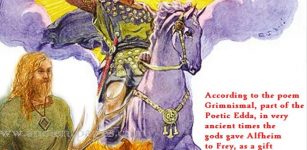 Frey – Handsome Vanir God Of Fertility And Lord Of The Elves In Norse Beliefs
Featured Stories | Mar 3, 2018
Frey – Handsome Vanir God Of Fertility And Lord Of The Elves In Norse Beliefs
Featured Stories | Mar 3, 2018 -
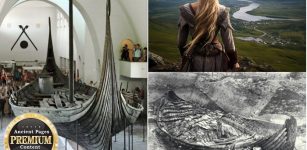 Why Is The Oseberg Ship Burial A Great Viking Mystery?
Vikings | Jan 22, 2024
Why Is The Oseberg Ship Burial A Great Viking Mystery?
Vikings | Jan 22, 2024 -
 Terracina – Ancient City Where Mythology And History Meet
Featured Stories | Jan 16, 2024
Terracina – Ancient City Where Mythology And History Meet
Featured Stories | Jan 16, 2024

